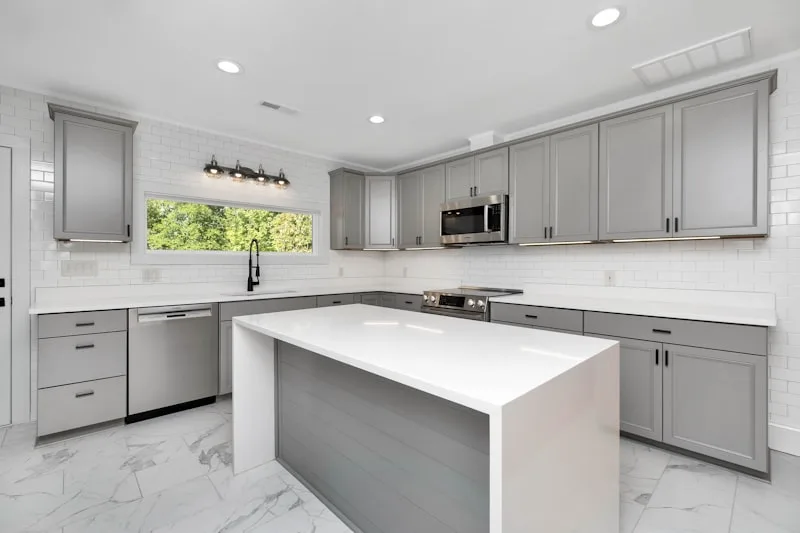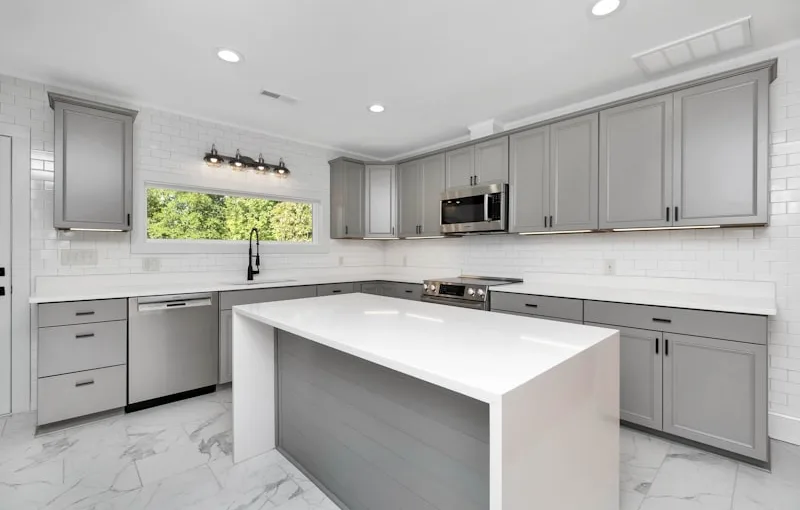Typically, the standard distance between the bottom of your upper cabinets and the top of your lower cabinets is around 18 inches. This space is like the sweet spot for most kitchens, allowing enough room for your countertop appliances while keeping everything within easy reach. Think of it as the perfect dance floor for your kitchen essentials—enough space to move around without bumping into each other.
But here’s where it gets interesting: this distance can vary based on your personal needs and the height of your ceilings. If you’re on the taller side, you might want to consider raising those upper cabinets a bit higher. After all, no one wants to feel like they’re playing limbo every time they grab a dish. On the flip side, if you’re shorter, you might prefer that 18-inch gap to be a little less, making everything more accessible.
Also, consider the type of tasks you do in your kitchen. If you’re a passionate cook, having that extra space can be a game-changer, allowing for more countertop prep area. It’s all about finding that balance that works for you. So, when planning your kitchen layout, don’t overlook this crucial detail—it’s the difference between a kitchen that feels cramped and one that flows like a well-rehearsed symphony.
The Perfect Fit: How to Measure the Ideal Distance Between Your Kitchen Cabinets
First off, think about your workflow. You want to create a space that feels natural and fluid. A good rule of thumb is to maintain at least 36 inches between your cabinets and any major appliances. This distance allows you to move around freely, like a dancer gliding across the floor. If you’re working with a kitchen island, aim for 42 to 48 inches of space around it. This way, you won’t feel like you’re in a game of kitchen Twister every time you reach for a pot.
Now, let’s talk about height. The distance between your upper and lower cabinets should ideally be around 18 inches. This height is like the sweet spot for most people, allowing easy access to your countertop while keeping everything within reach. If you’re on the taller side, you might want to adjust that a bit higher, just like how a basketball player needs a higher hoop.
Cabinet Spacing 101: Finding the Sweet Spot Between Top and Bottom Units
First off, let’s talk about height. You want your top cabinets to be accessible without needing a ladder. If you’re constantly reaching for that elusive spice jar on the top shelf, it’s time to rethink your spacing. A good rule of thumb is to leave about 18 inches between the countertop and the bottom of the upper cabinets. This gives you enough room to work without feeling cramped, like trying to dance in a tiny closet.
Now, let’s not forget about aesthetics. Think of your kitchen as a canvas. The spacing between your cabinets can create visual harmony. If your top cabinets are too high, they might look like they’re floating away, while too low can make the space feel cluttered. Aim for a cohesive look that draws the eye across the room, much like a well-composed photograph.
And what about the depth? If your upper cabinets are too deep, they can overshadow the lower units, making your kitchen feel like a cave. A depth of 12 inches for upper cabinets is usually ideal, allowing for easy access while keeping the space open and inviting.
So, as you plan your kitchen layout, remember that cabinet spacing is more than just measurements; it’s about creating a space that feels just right. It’s like finding the perfect pair of shoes—comfortable, stylish, and just the right fit for your lifestyle.
Maximizing Kitchen Efficiency: The Science Behind Cabinet Height and Spacing
First off, let’s talk about height. Ideally, your upper cabinets should be positioned so that you can easily access everything without needing a step stool. Think about it: if you’re constantly stretching or climbing, you’re wasting precious time and energy. A good rule of thumb is to install cabinets 18 inches above the countertop. This height allows for easy access while keeping your kitchen looking spacious and open.
Now, spacing is equally crucial. Have you ever opened a cabinet door only to have it clash with another? It’s like a game of kitchen Tetris! To avoid this, ensure there’s enough space between cabinets and appliances. A gap of at least 36 inches between the countertop and upper cabinets is ideal for most kitchens. This not only provides ample room for cooking but also makes it easier to maneuver around your kitchen.
And let’s not forget about the layout. The classic work triangle—your stove, sink, and refrigerator—should be easily navigable. If your cabinets are too high or too low, it can disrupt this flow, making cooking feel like a chore rather than a joy.
So, whether you’re a culinary whiz or a microwave master, understanding the science behind cabinet height and spacing can transform your kitchen into a well-oiled machine. It’s all about creating a space that works for you, making every meal prep feel like a breeze.
From Floor to Ceiling: What You Need to Know About Cabinet Distances in Your Kitchen
First off, think about the height of your cabinets. Standard upper cabinets are usually around 30 inches above the countertop. But if you’re tall or have a unique kitchen layout, you might want to adjust that. Picture this: you’re reaching for a spice jar on the top shelf, and it feels like you’re scaling a mountain. By raising those cabinets a bit, you can avoid that awkward stretch and make your cooking experience smoother.
Now, let’s talk about the space between your upper and lower cabinets. Ideally, you want about 18 inches of clearance. This distance is like the sweet spot—it gives you enough room to work without feeling cramped. Think of it as the breathing space your kitchen needs to feel open and inviting. If you go too low, you might find yourself ducking under cabinets like a limbo champion, and that’s not exactly the vibe you want.

And don’t forget about the distance between cabinets and appliances! You want to ensure that your fridge, oven, and dishwasher have enough room to breathe. A good rule of thumb is to leave at least 36 inches of clearance in front of appliances. This way, you can glide through your kitchen like a pro chef, without any awkward maneuvers.
Frequently Asked Questions
What is the Standard Height Between Kitchen Cabinets?
The standard height between kitchen cabinets typically ranges from 18 to 24 inches above the countertop. This spacing allows for comfortable access to kitchen items while ensuring adequate workspace and functionality.
How Far Should Upper Cabinets Be from Lower Cabinets?
The ideal distance between upper and lower cabinets is typically 18 inches. This height allows for comfortable workspace and accessibility while ensuring that the upper cabinets are easily reachable without obstructing movement in the kitchen.
Can I Customize the Height Between My Kitchen Cabinets?
Adjusting the height between kitchen cabinets is possible, allowing for a more tailored fit to your space. This can enhance functionality and aesthetics. Consult with a professional to determine the best approach for your specific kitchen layout and design preferences.
What is the Ideal Distance for Kitchen Cabinet Spacing?
The ideal distance for kitchen cabinet spacing typically ranges from 18 to 24 inches above the countertop. This height allows for comfortable access to items stored in the cabinets while ensuring adequate workspace. Additionally, maintaining consistent spacing between cabinets and appliances enhances functionality and aesthetics in the kitchen.
What Factors Affect the Distance Between Kitchen Cabinets?
The distance between kitchen cabinets is influenced by several factors, including the size of the kitchen, the height of the ceiling, the type of appliances, and the overall design layout. Proper spacing ensures functionality, accessibility, and aesthetic appeal, allowing for ease of movement and efficient use of space.
